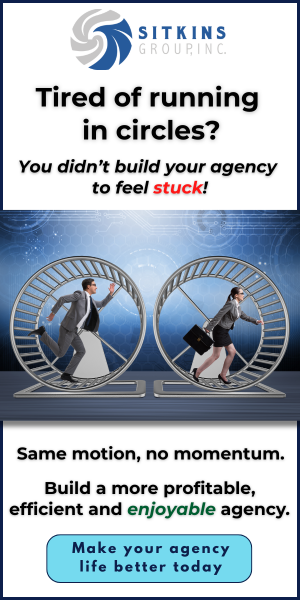Transactions vs. client relationships
By Patrick McBride
Agents love to complain about churn, but the truth is, most are driving their own clients away. If your agency is stuck in a sales-first mindset, do not be surprised when customers treat you like a transaction.
Insurance professionals take pride in calling themselves trusted advisors, but how often is that actually true?
For years, the industry has operated on a sales-first, commission-driven model where success is measured in premium volume and closing ratios rather than client outcomes and long-term relationships. Sales trainings focus on objection handling and perfecting the close, but when it comes to delivering real value beyond the premium, too many agents fall short.
It’s not that agents don’t care about their clients; it’s that they’re conditioned to treat policies as transactions rather than relationships.
Clients feel it. They sense when an agent is more concerned with making a sale than providing guidance. When they do not feel valued, they do what anyone in a transactional relationship would do. They leave.
Every time a client jumps ship, agents blame price shopping or lack of loyalty. But the truth is, if retention is an issue, the problem is not the client. It is the way the client is being treated.
Every agent has said it at some point: “Clients only care about price.” It is an easy excuse when a policyholder moves to another agency. But if price is the only thing keeping a client with you, then you have already lost them.
Client stories
Last year, a roofing company moved to our agency after receiving an enormous workers comp audit they had no idea was coming. For years, their previous agent had been laser-focused on keeping costs down. To do this, the agent underreported their gross sales and payrolls to lower their exposures and annual premium costs.
The problem was, he never communicated how this would impact them during an audit.
Then, year after year they grew. Having three consecutive years of consistent growth, and when the numbers didn’t match up during the inevitable audit, they were left with massive bills they weren’t prepared for and their agent didn’t explain.
By the time we stepped in, they were frustrated, not just with their former agent, but with the entire insurance industry. When you’re blindsided by something that could’ve easily been avoided with clear communication and proactive risk management, it is easy to lose trust.
At first, there was friction. Not because of anything we did, but because they had been burned before.
Instead of pushing a new policy, we had real conversations about their actual exposures. We worked to reduce their total cost of risk, not just their premium. We put the right policies in place, ones that would prevent surprises in the future. Because they are a seasonal business, we helped them move to a monthly self-reporting workers comp plan, which allowed them to manage cash flow throughout the year.
That is what providing value beyond the premium looks like. It is not about finding the lowest price. It is about helping clients build a stronger, more resilient business.
Some agents push the policies that pay them the most instead of what actually serves the client. It’s one of the most dangerous habits in the industry, and the worst part is that clients recognize when it is happening.
Not long ago, I spoke with a masonry contractor who specialized in EIFS (Exterior Insulation and Finish Systems). Right away, in our very first conversation, he asked me, “Can you handle EIFS?”
That question was a red flag.
I knew his current carrier well, and I knew they had absolutely no appetite for EIFS work. Not only did they avoid it, but their general liability policies also had a named exclusion for it.
I told him we could handle this and quickly asked what his current policy said. His hesitation said everything. “I don’t know, but my agent said I was good.”
I requested a copy of his policy and found exactly what I expected. A full EIFS exclusion. His coverage did not just limit EIFS work; it completely excluded it.
During our proposal I pointed this out, his expression shifted from one of confusion to frustration. “You are kidding, right? That’s nearly 85% of my business!”
No, I wasn’t kidding.
This was not a careless contractor. He was a professional with nearly 20 years’ experience who had been operating under the false assumption that he was covered. His previous agent either didn’t know or didn’t care enough to explain the exclusion to him.
The risk was not hypothetical. EIFS work is one of the most frequently litigated areas in construction due to moisture intrusion issues. One claim could have put him out of business.
We placed him with a carrier that understood and accepted his risks and wrote policies that covered it. The premium was higher, but it was real coverage, not an illusion.
This was not just a bad policy. It was a business-ending disaster waiting to happen. And he had no idea until we had that conversation.

Insurance professionals take pride in
calling themselves trusted advisors,
but how often is that actually true?
Best practices
Most agencies wait until renewal to reach out to their clients. By then, the conversation is transactional. If the client hasn’t heard from their agent all year, they assume the only reason for the call is to keep their business, not to provide value.
We’ve had the opportunity to observe agencies that excel at client retention and have taken key lessons from them to shape our own approach. The agencies that consistently keep their clients long-term all have one thing in common: They connect before they need to.
We implemented a mid-term connection process for all clients, not just commercial. The goal is simple: Confirm changes, identify portfolio needs, and connect on a human level. In that order. When we put the human connection as the last piece, it solidifies our commitment to them, not their policies.
At the six-month mark of a policy term, we reach out to see if anything has changed. For some clients, that means reviewing business operations or payroll. For others, it means checking in on life changes, home updates, or new drivers in the household. These conversations uncover the things that would otherwise slip through the cracks.
At 90 days before renewal, we start a pre-renewal process designed to eliminate surprises and reinforce trust. Before renewal, we:
- Proactively communicate with the client about what our process is.
- Review the policy internally to anticipate potential issues or gaps.
- Reach out to the client to discuss any changes, market shifts, or recommendations.
- Educate on premium changes early, so they’re not caught off guard.
By the time renewal arrives, our clients are already confident in their coverage and truly see our teams as trusted advisors, not just someone sending a bill.
If you find yourself being more transactional than relationship-focused, here are three ways we reframed our approach:
- We changed the seemingly default questions. Instead of asking, “What price do you need to be at?” we ask, “What’s going on, how can I help?” This shifts the conversation from cost to relationship. We still ask commercial prospects about target price, but it’s near the end of every discovery conversation to minimize it’s impact on the dialogue.
- We built a check-in system that’s not tied to renewal. If our only scheduled touchpoint is when a client’s policy is expiring, they have already assumed we’re just trying to keep their business. Sending them risk management tips, industry insights, market updates, or quick “how’s everything going?” calls throughout the year make a tremendous impact.
- We educate our clients. The more they understand about coverage, the less likely they are to shop purely on price. We walk them through their policies. We explain exclusions. We help them see us as a partner rather than just a vendor.
The best agents do not sell insurance. They solve problems. When they focus on that, the commissions take care of themselves.
The roofing contractor who we helped? He’s not just thriving—he’s expanding. Because of the monthly self-reporting workers comp plan we put in place, the off-season revenue that used to get locked into insurance costs is now being invested in a new opportunity. He’s in the process of purchasing a flooring business, diversifying his income, and securing his financial future. That didn’t happen because we found him a lower premium. It happened because we looked beyond the policy and helped him take control of his total cost of risk.
If you’re running an agency that operates on a transactional model, don’t complain when your clients leave. This is what you trained them to do. The agencies that will thrive are the ones that build relationships, provide value beyond the premium, and show up before they’re needed.
The question is, what kind of agency are you building?

The author
Patrick McBride is a seasoned insurance professional, business owner, and technology advocate dedicated to using innovation to support people—not replace them. As the owner of The McBride Agency in Dixon, Illinois, and co-founder of TechMarketer, he leverages technology to reduce friction, create efficiency, and give both clients and teams more mental and emotional capacity in their day. A former Marine and experienced speaker, Patrick focuses on operational strategies that enhance human connection, ensuring insurance remains a people-first industry.





